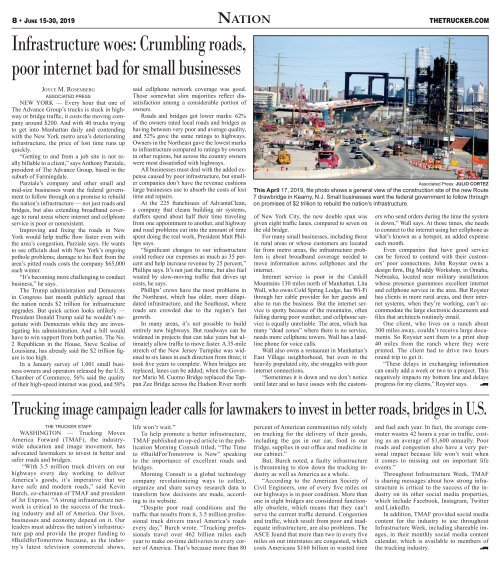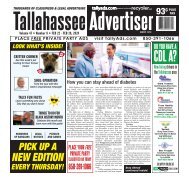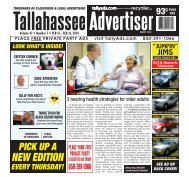TT_061519_AllPages
You also want an ePaper? Increase the reach of your titles
YUMPU automatically turns print PDFs into web optimized ePapers that Google loves.
8 • June 15-30, 2019 Nation<br />
THETRUCKER.COM<br />
Infrastructure woes: Crumbling roads,<br />
poor internet bad for small businesses<br />
Joyce M. Rosenberg<br />
ASSOCIATED PRESS<br />
NEW YORK — Every hour that one of<br />
The Advance Group’s trucks is stuck in highway<br />
or bridge traffic, it costs the moving company<br />
around $200. And with 40 trucks trying<br />
to get into Manhattan daily and contending<br />
with the New York metro area’s deteriorating<br />
infrastructure, the price of lost time runs up<br />
quickly.<br />
“Getting to and from a job site is not really<br />
billable to a client,” says Anthony Parziale,<br />
president of The Advance Group, based in the<br />
suburb of Farmingdale.<br />
Parziale’s company and other small and<br />
mid-size businesses want the federal government<br />
to follow through on a promise to rebuild<br />
the nation’s infrastructure — not just roads and<br />
bridges, but also extending broadband coverage<br />
to rural areas where internet and cellphone<br />
service is poor or nonexistent.<br />
Improving and fixing the roads in New<br />
York would help traffic flow faster even with<br />
the area’s congestion, Parziale says. He wants<br />
to see officials deal with New York’s ongoing<br />
pothole problems; damage to his fleet from the<br />
area’s pitted roads costs the company $65,000<br />
each winter.<br />
“It’s becoming more challenging to conduct<br />
business,” he says.<br />
The Trump administration and Democrats<br />
in Congress last month publicly agreed that<br />
the nation needs $2 trillion for infrastructure<br />
upgrades. But quick action looks unlikely —<br />
President Donald Trump said he wouldn’t negotiate<br />
with Democrats while they are investigating<br />
his administration. And a bill would<br />
have to win support from both parties. The No.<br />
2 Republican in the House, Steve Scalise of<br />
Louisiana, has already said the $2 trillion figure<br />
is too high.<br />
In a January survey of 1,001 small business<br />
owners and operators released by the U.S.<br />
Chamber of Commerce, 56% said the quality<br />
of their high-speed internet was good, and 58%<br />
said cellphone network coverage was good.<br />
Those somewhat slim majorities reflect dissatisfaction<br />
among a considerable portion of<br />
owners.<br />
Roads and bridges got lower marks: 62%<br />
of the owners rated local roads and bridges as<br />
having between very poor and average quality,<br />
and 52% gave the same ratings to highways.<br />
Owners in the Northeast gave the lowest marks<br />
to infrastructure compared to ratings by owners<br />
in other regions, but across the country owners<br />
were most dissatisfied with highways.<br />
All businesses must deal with the added expense<br />
caused by poor infrastructure, but smaller<br />
companies don’t have the revenue cushions<br />
large businesses use to absorb the costs of lost<br />
time and repairs.<br />
At the 225 franchisees of AdvantaClean,<br />
a company that cleans building air systems,<br />
staffers spend about half their time traveling<br />
from one appointment to another, and highway<br />
and road problems cut into the amount of time<br />
spent doing the real work, President Matt Phillips<br />
says.<br />
“Significant changes to our infrastructure<br />
could reduce our expenses as much as 35 percent<br />
and help increase revenue by 25 percent,”<br />
Phillips says. It’s not just the time, but also fuel<br />
wasted by slow-moving traffic that drives up<br />
costs, he says.<br />
Phillips’ crews have the most problems in<br />
the Northeast, which has older, more dilapidated<br />
infrastructure, and the Southeast, where<br />
roads are crowded due to the region’s fast<br />
growth.<br />
In many areas, it’s not possible to build<br />
entirely new highways. But roadways can be<br />
widened in projects that can take years but ultimately<br />
allow traffic to move faster. A 35-mile<br />
stretch of the New Jersey Turnpike was widened<br />
to six lanes in each direction from three; it<br />
took five years to complete. When bridges are<br />
replaced, lanes can be added; when the Governor<br />
Mario M. Cuomo Bridge replaced the Tappan<br />
Zee Bridge across the Hudson River north<br />
Associated Press: JULIO CORTEZ<br />
This April 17, 2019, file photo shows a general view of the construction site of the new Route<br />
7 drawbridge in Kearny, N.J. Small businesses want the federal government to follow through<br />
on promises of $2 trillion to rebuild the nation’s infrastructure.<br />
of New York City, the new double span was<br />
given eight traffic lanes, compared to seven on<br />
the old bridge.<br />
For many small businesses, including those<br />
in rural areas or whose customers are located<br />
far from metro areas, the infrastructure problem<br />
is about broadband coverage needed to<br />
move information across cellphones and the<br />
internet.<br />
Internet service is poor in the Catskill<br />
Mountains 130 miles north of Manhattan. Lita<br />
Wall, who owns Cold Spring Lodge, has Wi-Fi<br />
through her cable provider for her guests and<br />
also to run the business. But the internet service<br />
is spotty because of the mountains, often<br />
failing during poor weather, and cellphone service<br />
is equally unreliable. The area, which has<br />
many “dead zones” where there is no service,<br />
needs more cellphone towers. Wall has a landline<br />
phone for voice calls.<br />
Wall also owns a restaurant in Manhattan’s<br />
East Village neighborhood, but even in the<br />
heavily populated city, she struggles with poor<br />
internet connections.<br />
“Sometimes it is down and we don’t notice<br />
until later and so have issues with the customers<br />
who send orders during the time the system<br />
is down,” Wall says. At those times, she needs<br />
to connect to the internet using her cellphone as<br />
what’s known as a hotspot, an added expense<br />
each month.<br />
Even companies that have good service<br />
can be forced to contend with their customers’<br />
poor connections. John Royster owns a<br />
design firm, Big Muddy Workshop, in Omaha,<br />
Nebraska, located near military installations<br />
whose presence guarantees excellent internet<br />
and cellphone service in the area. But Royster<br />
has clients in more rural areas, and their internet<br />
systems, when they’re working, can’t accommodate<br />
the large electronic documents and<br />
files that architects routinely email.<br />
One client, who lives on a ranch about<br />
300 miles away, couldn’t receive large documents.<br />
So Royster sent them to a print shop<br />
40 miles from the ranch where they were<br />
printed. The client had to drive two hours<br />
round trip to get it.<br />
“These delays in exchanging information<br />
can easily add a week or two to a project. This<br />
negatively impacts my bottom line and delays<br />
progress for my clients,” Royster says. 8<br />
Trucking image campaign leader calls for lawmakers to invest in better roads, bridges in U.S.<br />
THE TRUCKER STAFF<br />
WASHINGTON — Trucking Moves<br />
America Forward (TMAF), the industrywide<br />
education and image movement, has<br />
advocated lawmakers to invest in better and<br />
safer roads and bridges.<br />
“With 3.5 million truck drivers on our<br />
highways every day working to deliver<br />
America’s goods, it’s imperative that we<br />
have safe and modern roads,” said Kevin<br />
Burch, co-chairman of TMAF and president<br />
of Jet Express. “A strong infrastructure network<br />
is critical to the success of the trucking<br />
industry and all of America. Our lives,<br />
businesses and economy depend on it. Our<br />
leaders must address the nation’s infrastructure<br />
gap and provide the proper funding to<br />
#BuildforTomorrow because, as the industry’s<br />
latest television commercial shows,<br />
life won’t wait.”<br />
To help promote a better infrastructure,<br />
TMAF published an op-ed article in the publication<br />
Morning Consult titled, “The Time<br />
to #BuildForTomorrow is Now” speaking<br />
to the importance of excellent roads and<br />
bridges.<br />
Morning Consult is a global technology<br />
company revolutionizing ways to collect,<br />
organize and share survey research data to<br />
transform how decisions are made, according<br />
to its website.<br />
“Despite poor road conditions and the<br />
traffic that results from it, 3.5 million professional<br />
truck drivers travel America’s roads<br />
every day,” Burch wrote. “Trucking professionals<br />
travel over 462 billion miles each<br />
year to make on-time deliveries to every corner<br />
of America. That’s because more than 80<br />
percent of American communities rely solely<br />
on trucking for the delivery of their goods,<br />
including the gas in our car, food in our<br />
fridge, supplies in our office and medicine in<br />
our cabinet.”<br />
But, Burch noted, a faulty infrastructure<br />
is threatening to slow down the trucking industry<br />
as well as America as a whole.<br />
“According to the American Society of<br />
Civil Engineers, one of every five miles on<br />
our highways is in poor condition. More than<br />
one in eight bridges are considered functionally<br />
obsolete, which means that they can’t<br />
serve the current traffic demand. Congestion<br />
and traffic, which result from poor and inadequate<br />
infrastructure, are also problems. The<br />
ASCE found that more than two in every five<br />
miles on our interstates are congested, which<br />
costs Americans $160 billion in wasted time<br />
and fuel each year. In fact, the average commuter<br />
wastes 42 hours a year in traffic, costing<br />
us an average of $1,600 annually. Poor<br />
roads and congestion also have a very personal<br />
impact because life won’t wait when<br />
it comes to missing out on important life<br />
events.”<br />
Throughout Infrastructure Week, TMAF<br />
is sharing messages about how strong infrastructure<br />
is critical to the success of the industry<br />
on its other social media properties,<br />
which include Facebook, Instagram, Twitter<br />
and LinkedIn.<br />
In addition, TMAF provided social media<br />
content for the industry to use throughout<br />
Infrastructure Week, including shareable images,<br />
in their monthly social media content<br />
calendar, which is available to members of<br />
the trucking industry. 8

















